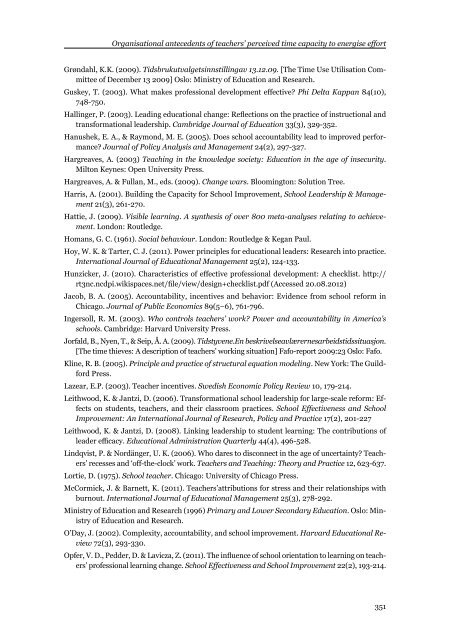Download issue - Umeå universitet
Download issue - Umeå universitet
Download issue - Umeå universitet
Create successful ePaper yourself
Turn your PDF publications into a flip-book with our unique Google optimized e-Paper software.
Organisational antecedents of teachers’ perceived time capacity to energise effort<br />
Grøndahl, K.K. (2009). Tidsbrukutvalgetsinnstillingav 13.12.09. [The Time Use Utilisation Committee<br />
of December 13 2009] Oslo: Ministry of Education and Research.<br />
Guskey, T. (2003). What makes professional development effective? Phi Delta Kappan 84(10),<br />
748-750.<br />
Hallinger, P. (2003). Leading educational change: Reflections on the practice of instructional and<br />
transformational leadership. Cambridge Journal of Education 33(3), 329-352.<br />
Hanushek, E. A., & Raymond, M. E. (2005). Does school accountability lead to improved performance?<br />
Journal of Policy Analysis and Management 24(2), 297-327.<br />
Hargreaves, A. (2003) Teaching in the knowledge society: Education in the age of insecurity.<br />
Milton Keynes: Open University Press.<br />
Hargreaves, A. & Fullan, M., eds. (2009). Change wars. Bloomington: Solution Tree.<br />
Harris, A. (2001). Building the Capacity for School Improvement, School Leadership & Management<br />
21(3), 261-270.<br />
Hattie, J. (2009). Visible learning. A synthesis of over 800 meta-analyses relating to achievement.<br />
London: Routledge.<br />
Homans, G. C. (1961). Social behaviour. London: Routledge & Kegan Paul.<br />
Hoy, W. K. & Tarter, C. J. (2011). Power principles for educational leaders: Research into practice.<br />
International Journal of Educational Management 25(2), 124-133.<br />
Hunzicker, J. (2010). Characteristics of effective professional development: A checklist. http://<br />
rt3nc.ncdpi.wikispaces.net/file/view/design+checklist.pdf (Accessed 20.08.2012)<br />
Jacob, B. A. (2005). Accountability, incentives and behavior: Evidence from school reform in<br />
Chicago. Journal of Public Economics 89(5–6), 761-796.<br />
Ingersoll, R. M. (2003). Who controls teachers’ work? Power and accountability in America’s<br />
schools. Cambridge: Harvard University Press.<br />
Jorfald, B., Nyen, T., & Seip, Å. A. (2009). Tidstyvene.En beskrivelseavlærernesarbeidstidssituasjon.<br />
[The time thieves: A description of teachers’ working situation] Fafo-report 2009:23 Oslo: Fafo.<br />
Kline, R. B. (2005). Principle and practice of structural equation modeling. New York: The Guildford<br />
Press.<br />
Lazear, E.P. (2003). Teacher incentives. Swedish Economic Policy Review 10, 179-214.<br />
Leithwood, K. & Jantzi, D. (2006). Transformational school leadership for large-scale reform: Effects<br />
on students, teachers, and their classroom practices. School Effectiveness and School<br />
Improvement: An International Journal of Research, Policy and Practice 17(2), 201-227<br />
Leithwood, K. & Jantzi, D. (2008). Linking leadership to student learning: The contributions of<br />
leader efficacy. Educational Administration Quarterly 44(4), 496-528.<br />
Lindqvist, P. & Nordänger, U. K. (2006). Who dares to disconnect in the age of uncertainty? Teachers’<br />
recesses and ‘off-the-clock’ work. Teachers and Teaching: Theory and Practice 12, 623-637.<br />
Lortie, D. (1975). School teacher. Chicago: University of Chicago Press.<br />
McCormick, J. & Barnett, K. (2011). Teachers’attributions for stress and their relationships with<br />
burnout. International Journal of Educational Management 25(3), 278-292.<br />
Ministry of Education and Research (1996) Primary and Lower Secondary Education. Oslo: Ministry<br />
of Education and Research.<br />
O’Day, J. (2002). Complexity, accountability, and school improvement. Harvard Educational Review<br />
72(3), 293-330.<br />
Opfer, V. D., Pedder, D. & Lavicza, Z. (2011). The influence of school orientation to learning on teachers’<br />
professional learning change. School Effectiveness and School Improvement 22(2), 193-214.<br />
351

















